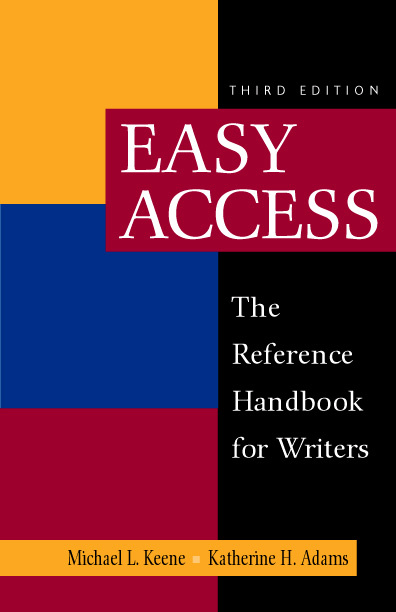 |  Easy Access: The Reference Handbook for Writers, 3/e Michael L. Keene,
The University of Tennessee, Knoxville
Katherine H. Adams,
Loyola University New Orleans
Features1. Unique three-part structure. Part One, “Processes and Products,” presents reliable guides to the writing process, the research process, argumentation, documentation styles, document design, and special writing situations such as oral presentations. Part Two, “Common Writing Problems,” highlights the ten most common writing problems and ESL troublespots and provides detailed guides to identifying and correcting each problem, as well as exercises. Part Three, “The Basics from A to Z,” offers alphabetically organized definitions of terms and concepts that are central grammar, mechanics, and punctuation.
2. Tabbed section dividers. This edition provides 12 tabbed section dividers: (1) Processes and Products; (2) Research Writing; (3) Argumentation; (4) MLA Documentation Style; (5) APA Documentation Style; (6) Document Design; (7) Special Writing Situations; (8) Common Writing Problems; (9) For ESL Writers; (10) The Basics from A to Z; (11) Glossary of Usage; (12) Index.
3. Extensive coverage of the Internet and computers and writing.
4. Substantial argumentation, critical thinking, and critical reading coverage.
5. A clean, four-color design that is pleasing and easy to navigate.
6. Abundant visual reference aids.
7. Extensive coverage of document design.
8. Coverage of MLA, APA, CBE, and CMS documentation styles.
9. Numerous examples of student writing, including model papers.
10. Abundant help for ESL students.
11. Exercises in Part Two. Easy Access is one of the few reference handbooks to include practice exercises in the text itself.
12. Coverage of oral presentations. This coverage details how to prepare a text for presentation and how to use visuals (including electronic ones) during a presentation.
13. Practical coverage of professional writing, including internships and job application letters.
14. Especially helpful coverage of writing essay exams. Reviewers consistently praised this section, which covers each phase of the writing process in this context and includes guidance for analyzing exam questions.
15. Clear and concise writing style, and a friendly, unpretentious tone.
Examples in “hand-written” (instead of “before and after”) format. This allows students to see at a glance what’s been changed in the sentence, while reinforcing the habit of proofreading.
|
|



 2002 McGraw-Hill Higher Education
2002 McGraw-Hill Higher Education

 2002 McGraw-Hill Higher Education
2002 McGraw-Hill Higher Education